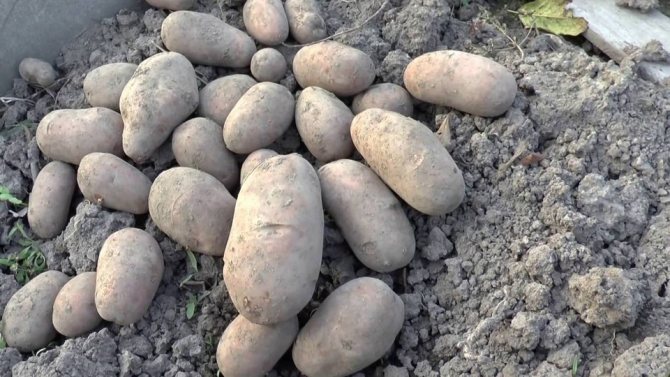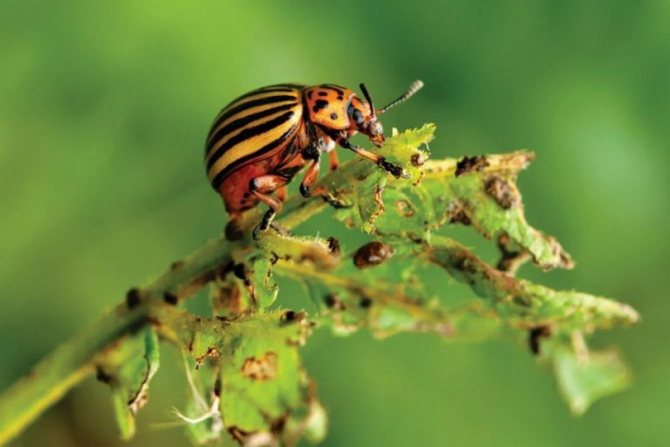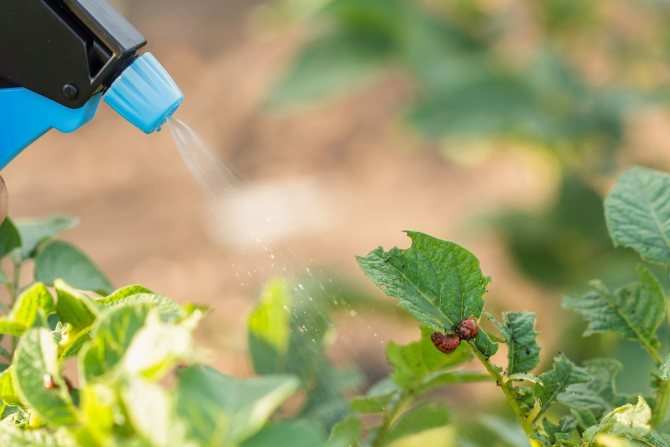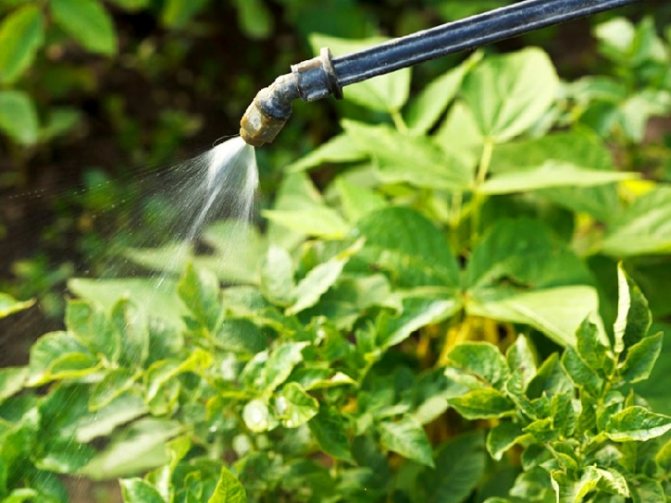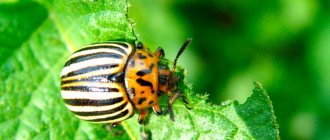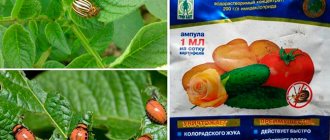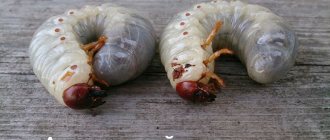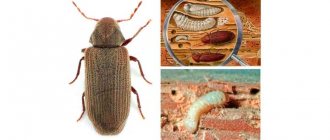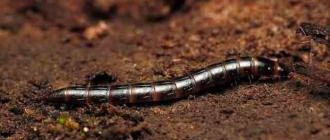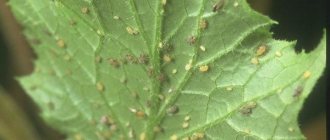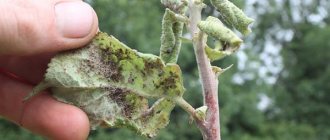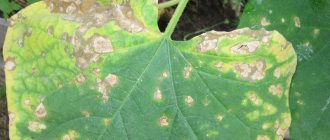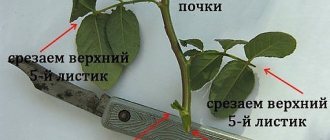Why is the Colorado potato beetle dangerous?
The adults of the Colorado potato beetle are not as dangerous as its voracious larvae. One female can lay up to 1000 eggs per season. The hatched larvae are capable of destroying the potato tops in a matter of days and causing irreparable damage to the crop.
The fight against the Colorado potato beetle is complicated by the fact that the insect has practically no natural enemies in nature, and under adverse environmental conditions it can hibernate, sometimes lasting 2-3 years. Colorado beetles hibernate deep in the soil and survive even in the most severe frosts. They easily move from one garden to another, so if the neighbors are resigned to the presence of this pest on the site, it will be extremely difficult to exterminate it. If, after treatment with chemicals, at least one female remains alive, the population of the Colorado potato beetle will be restored.
Comment! The Colorado potato beetle owes its name to one of the American states, in which in 1959 it almost completely destroyed the potato planting.
Useful tips to save your potato harvest
In order to maximize the protection of potato plantings from pests, a number of rules should be followed:
- observe crop rotation;
- place plots for planting potatoes at a remote distance from nightshade and pumpkin crops;
- in the fall, deep digging of potato beds, and during the growing season - regular weeding of row spacings;
- hilling the beds, the lower leaves should be filled up higher - this contributes to the destruction of egg-laying on them;
- mulch the soil with needles or straw, which will determine not only effective weed control, protection from direct sunlight and preservation of moisture in the soil, but also create favorable conditions for insects - potential enemies of the Colorado potato beetle (these are ladybugs, praying mantises, ground beetles);
- after harvesting, leave the site in absolute cleanliness, taking out all plant residues into the fields.
How to get rid of the Colorado potato beetle on potatoes
For the fight against the Colorado potato beetle on potatoes to be effective, you need to study the life cycle of the insect and understand its weaknesses and sides. The female lays small oblong eggs of bright yellow or orange color on the back of the leaves. One masonry can be 25-80 pcs. If you find eggs on time, you can avoid many problems in the future, because after 5 days chubby larvae will hatch from them, which differ in a simply monstrous appetite. Within 2-3 weeks, they grow rapidly, eating the soft parts of the potato tops and leaving only stems and veins on the leaves on the bush. At this stage of development, they can be harvested by hand, and the larvae have a bright dirty pink or salmon coloration with contrasting black dots. Manual collection of the Colorado potato beetle on potatoes is advisable only in the case of small planting areas; on an industrial scale, it is necessary to treat the fields with special preparations.
The grown larvae descend from the ground part of the potato and go deeper into the soil to go through another stage of development - pupation. For the next 3 weeks, they live in the ground, after which a young, fully formed beetle crawls out to the surface.He can fly to other fields, while covering considerable distances. Under unfavorable conditions, after pupation, the Colorado potato beetle remains in the ground until the next spring.
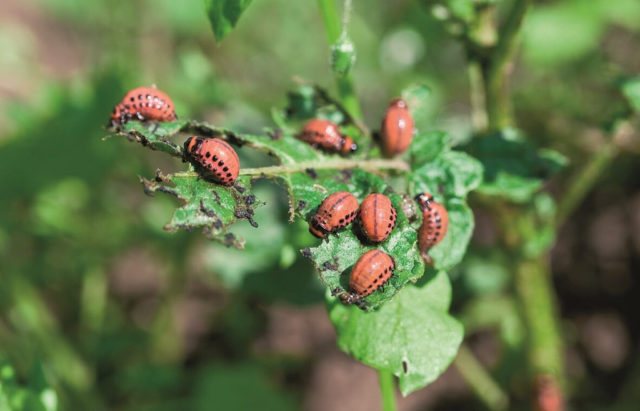
Agrotechnical measures
To reduce the population of the Colorado potato beetle, the following agricultural rules must be observed:
- Plant early maturing and pest-resistant potato varieties.
- Use high-quality planting material, since the beetle often infects weak and diseased plants.
- Planting work as early as possible, generously adding organic matter and wood ash to the holes.
- When digging a field in autumn, add superphosphate to the soil (1-1.5 kg per hundred square meters).
- Systematically spud potato beds.
- Mow the potato tops early (1-2 weeks before digging out the tubers).
- Plant next to potatoes crops that repel the Colorado potato beetle.
Treatment of potatoes from the Colorado potato beetle with drugs
The first processing of potatoes from the Colorado potato beetle is carried out before planting. This procedure not only allows you to protect the planting material from pests, but also performs a number of additional functions:
- has antifungal effect;
- activates the germination of eyes;
- reduces the number of treatments during the growing season, thereby reducing the concentration of chemicals in root crops;
- provides leveling of fractions, increasing the share of marketable potatoes by more than 20%;
- facilitates the care of the culture as a whole.
Potato tubers are pickled from the Colorado potato beetle 3 days before or just before planting. For these purposes, a spray bottle with a volume of 0.5-2 liters is used. The potatoes are laid out on a thick cloth or film, sprayed on one side and allowed to dry. Further, the tubers are turned upside down and the procedure is repeated. Once completely dry, the potatoes are ready for planting. You should remember about personal protective equipment: when processing, use a mask or respirator, gloves and overalls.
Advice! Experts recommend using different preparations during processing so that the Colorado potato beetle does not develop immunity to a certain means of control.
Subsequent treatments are carried out as the Colorado potato beetle is found on the potato and the extent of its distribution. The time depends on the early maturity of the variety.
Natural enemies
The main enemy of the Colorado potato beetle in nature is a large predatory bug - Picromerus Bidens. It can be found both in the garden and in the garden. At first glance, it may seem that bedbugs are harmful to berry and vegetable crops. They can actually eat fruits, but berries make up a negligible part of their diet. The main food of bedbugs is other insects; there are about 250 species on the picromerus menu. Unlike other members of the family, this species prefers to settle in cool climates. Pikromerus is widespread in the European part of the CIS, Russia, and Northern Europe.
Picromerus bugs are bred in biolabs and can be bought easily. Well-known agricultural plants for the production of biological agents for the control of the Colorado potato beetle are:
- agro;
- AOZT "Agrokombinat" Moskovsky ".
The eggs of the pikromerus bug are mixed with an adhesive and a small amount of water, applied to the leaves of the potato with a brush. You can pre-hatch the larvae by placing the eggs in a warm place for 1-2 weeks. After that, they are planted on potato tops. The most significant disadvantage of using the picromerus bug as a means of fighting the Colorado potato beetle is its omnivorousness (it can switch from the beetle to other insects) and the likelihood that the bugs will fly away to other areas.
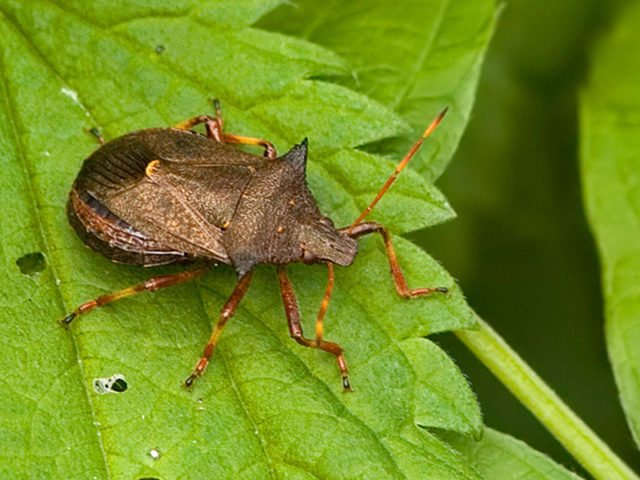

Another enemy of the Colorado potato beetle is the guinea fowl. Only specially trained birds eat harmful insects.It is not difficult to teach guinea fowls to peck beetles, they quickly understand what a delicacy it is, and after a week they independently bypass the potato fields, catching the pest to the indescribable joy of the gardener. For the same purposes, some farms use turkeys.


Traps
If it is not possible to process potatoes from the Colorado potato beetle, traps can be used. In the spring, when the ground part of the potato has not yet grown, the beetles happily feed on the tubers left in the ground after harvesting. It was during this period that baits are used to catch adults:
- Take a liter glass jar, cut a few potatoes into it.
- The container is dropped between the rows so that the upper edge is level with the ground.
- The neck of the jar is coated with potato juice to attract the attention of the beetles.
- Insects will crawl to the smell and get into a jar, from which they can no longer get out.
- The gardener can only collect containers and dispose of pests.
- One liter can is enough for 5 m².
In the fall, you can use a potato leaf trap, which is cut 7-14 days before harvest. The beetles will crawl to the heap, where they can be collected and destroyed.
Scarers
A number of scientists have come to the conclusion that repellent plants are effective in the fight against the striped pest of potatoes. Basically, their action is based on the content of essential oils in the leaves and stems. Some of these cultures are capable of stupefying and disorienting insects, preventing them from functioning normally. In the aisles or along the border of the potato field, many gardeners sow the following protective plants:
- spring garlic;
- calendula;
- beets;
- cilantro;
- legumes;
- nasturtium;
- marigold;
- coriander.
Natural Ways to Deal with Pests
The best ways that are safe for people, animals and the environment include years of experience using folk recipes. The energy expended pays off with a good, environmentally friendly harvest.
- You can remove insects manually. However, there is a way to make this process easier. Throw off pests from each bush with a broom into a bucket. After collecting insects, you need to move to another place away from your site.
- Spray foliage with decoctions of useful plants. These include - wormwood, horsetail, calendula, tobacco, mustard. You can also add onion husks to this list. The procedure should be carried out in the dark, since the beneficial properties of the broth disappear under the influence of sunlight.
- Covering the beds with straw or grass is good at reducing the number of beetles.
- An excellent remedy is to sprinkle the leaves with ash from the trees, or spray them with an infusion of ash and wormwood. Such a remedy completely removes insects from the garden.
It is very important to do all the procedures systematically, preventing insects from reappearing. Treat pests as soon as you find insects in your area. Indeed, if the insect destroys a little less than half of the foliage, then about a third of the crop will be lost.
Processing time for potatoes from the Colorado potato beetle
The fight against the Colorado potato beetle on early potato varieties begins from the moment the first clutches are found on the inside of the leaves. Re-spray early potatoes from the Colorado potato beetle after 10-14 days. Medium and late varieties are cultivated when a large number of adults and larvae of different sizes are present on the tops.
Spraying of potatoes from the Colorado potato beetle is carried out in dry, calm weather. With increased air humidity, the concentration of the drug and the efficiency of treatment decrease. In the heat, there will be an increased evaporation of pesticides from the surface of potato tops, which is dangerous for humans and domestic animals.
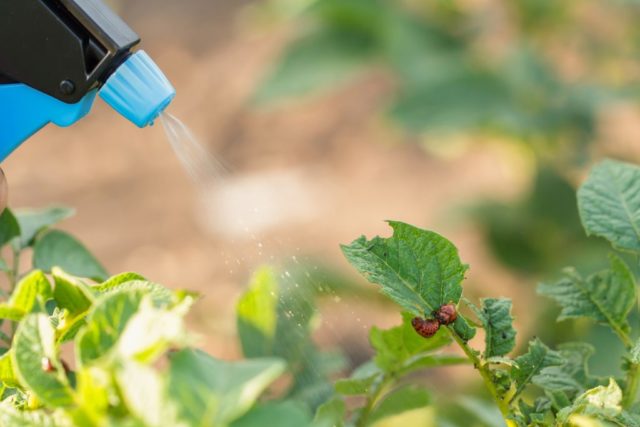

It is better to have time to process potatoes from the Colorado potato beetle early in the morning, until about 9 o'clock, or irrigate in the evening when the sun is on the horizon. It is important that there are no raindrops or dew on the leaves.
A warning! Do not spray potatoes with chemicals during the flowering period.
How to poison the Colorado potato beetle on potatoes
You can poison the Colorado potato beetle on potatoes with the help of biological preparations and chemical control agents. The use of the former is preferable, since there are no potent poisons in their composition.
Insecticides
Fighting the Colorado potato beetle on potatoes with chemicals is the most effective way to almost completely get rid of the pest or completely reduce its number. The use of pesticides also has the other side of the coin: along with harmful insects, useful ones, for example, bees, can also suffer.
The following table lists the most effective and proven drugs for chemical control of the Colorado potato beetle:
| Name | Active substance | Features of the |
| "Colorado" | Neonicotinoid Imidacloprid | When the drug enters the pest's body, the insect begins to convulse, paralyzes it a little later, and subsequently dies. One treatment is enough. The effectiveness of the product does not depend on weather conditions, since it penetrates into plant tissues |
| "Regent" | Fipronil | It has a contact and intestinal effect. Does not lose effectiveness at high temperatures. Destroys both adults and larvae. Differs in high toxicity |
| "Aktara" | Thiamethoxam | It has a paralytic effect, the beetles stop feeding after 30 minutes, the death of insects occurs within 24 hours after treatment. The drug penetrates into the green parts of the plant, the effect lasts for 5-7 weeks |
| "Confidor Extra" | Imidacloprid | Low-toxic drug for contact and systemic action. The poisonous substance does not accumulate in the fruit. The new mechanism of action eliminates addiction to the components of the product |
| "Killer" | Cypermethrin, chlorpyrifos | Quickly destroys larvae and beetles in a single spray |
| "Sonnet" | Hexaflumuron | Quickly destroys the chitinous layer of adults, destructive to larvae and eggs |
| "Corado" | Imidacloprid | This remedy has a systemic, contact and intestinal effect. Not addictive for 3 years. "Corado" cannot be used together with other insecticides and fertilizers |
| "Commander-Maxi" | Imidacloprid | Triple action insecticide. 100% result 3 days after treatment. Does not lose effectiveness in the heat |
| "Lightning" | Lambda Cyhalothrin | Contact-intestinal insecticide with acaricidal effect. Has a fast action, the protective period is up to 3 weeks |
| "Tanrek" | Imidacloprid | Acts similarly to "Commander-Maxi". Differs in a low consumption rate |
| "Taboo" | Imidacloprid | Insecticide, systemic disinfectant of tubers against seedling pests and insects living in the soil |
| Iskra Zolotaya | Imidacloprid | One treatment per season is sufficient to ensure reliable protection. Stored in the ground part of the plant for up to 30 days |
| "Destroy" | Lambda-cyhalothrin, imidacloprid | Acts on adults and larvae at any stage of development. Does not lose effectiveness at low temperatures |
A warning! Potatoes can be eaten 20 days after treatment with chemical control agents - during this time, the poisons will have time to decompose into compounds that are safe for the body.
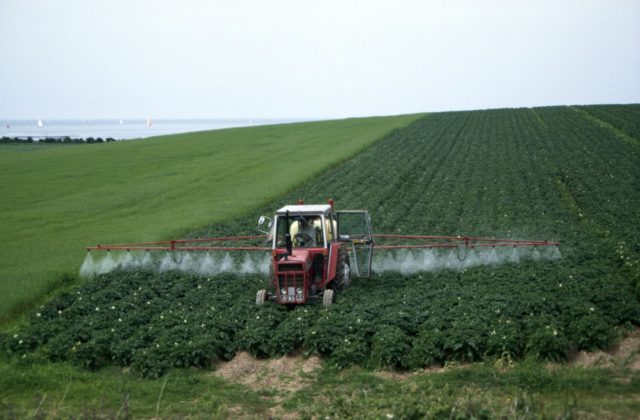

Biologicals
Biological means of control do not harm anyone except the Colorado beetles themselves. The active substances in their composition are not hazardous when released into water, air or young potatoes. The main weapons of biological products are extracts of pathogenic fungi and bacterial cultures, which have a destructive effect on the insect organism.Biological agents against the Colorado potato beetle destroy adults and larvae, but do not harm the eggs, so they must be used in several passes, observing the interval, according to the instructions. The most popular biologics:
- Fitoverm;
- "Agravertin";
- Boverin;
- "Bitoxibacillin".

